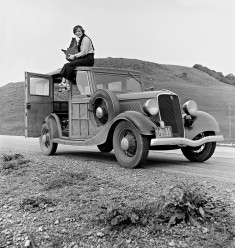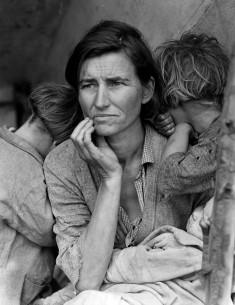| Dorothea Lange | |
|---|---|
 |
|
| Photographer | |
| Born | May 26, 1895 Hoboken, New Jersey |
| Died | Oct. 11, 1965 (at age 70) San Francisco, California |
| Nationality | American |
Born on May 26th, 1895, in Hoboken, New Jersey, Dorothea Lange was a prominent and highly influential photojournalist and documentary photographer who worked for the Farm Security Administration (FSA) during the Great Depression. Her main task was to show the consequences of the Great Depression.
Early Life
Born Dorothea Margaretta Nutzhorn, the famous American photographer was the daughter of a second-generation German immigrant. At age seven, she contracted polio, a disease which left a permanent mark on her life – an altered gait and a weakened right leg.
Her father abandoned Dorothea and her mother when she was only twelve, which was a traumatic event in her life which determined her to change her last name into Lange, her mother’s maiden name. Dorothea studied photography under American photographer Clarence Hudson White at Columbia University in New York and she was apprenticed to the renowned Arnold Genthe’s photography studio in NY.
When she was 23, she moved to San Francisco where she opened a commercial portrait studio. In 1920, she married painter Maynard Dixon and the couple had two sons, Daniel Rhoades (born in 1925) and John Eaglesfeather Dixon (born in 1930). In the early 1930s, her photographs depicting homeless and unemployed men and women wandering the streets in search of work caught the eye of the FSA, for which she worked between 1935 and 1939. In 1935, she married the Professor of Economics at Berkeley, Paul Schuster Taylor.
Lange’s Major Works
Lange’s distinctive documentary style in photography achieved its maximum expression during the Great Depression years with her photos becoming recognizable symbols of that economically harsh period of time. On her way home to Berkeley, California, in March of 1936, after completing a series of photographs for the FSA, Lange instinctually stopped her car in a soggy and wet pea-picker’s campsite. She found a devastated woman, mother of seven, all sheltered in a makeshift tent.
 The now-famous woman was Florence Owens Thompson (1903-1983), an agricultural worker who was forced to sell the tires from her family’s car to buy food for her children. Dorothea Lange photographed with her giant camera (for nearly ten minutes) the scene depicting the poverty-stricken family surrounded by the bleak landscape, her last shot being the close-up iconic image of the woman and three of her children, which represented the utterly famous photo Migrant Mother.
The now-famous woman was Florence Owens Thompson (1903-1983), an agricultural worker who was forced to sell the tires from her family’s car to buy food for her children. Dorothea Lange photographed with her giant camera (for nearly ten minutes) the scene depicting the poverty-stricken family surrounded by the bleak landscape, her last shot being the close-up iconic image of the woman and three of her children, which represented the utterly famous photo Migrant Mother.
Her portraits of displaced and poverty-stricken farmers and migrant workers during the Great Depression were a major influence on the later work of other famous photojournalists and documentary photographers.
In 1941, Dorothea Lange was honored with a Guggenheim Fellowship for her exceptional creative abilities in the art of photography.
Death and Legacy
Dorothea Lange passed away at the age of 70, on October 11, 1965, in San Francisco, California. The cause of death was esophageal cancer. She was survived by her two sons with her first husband and by her second husband Paul Taylor.
In 2008, Lange was inducted into the California Hall of Fame for her outstanding contribution to the development of documentary photography and her son accepted the honor on his mother’s behalf.